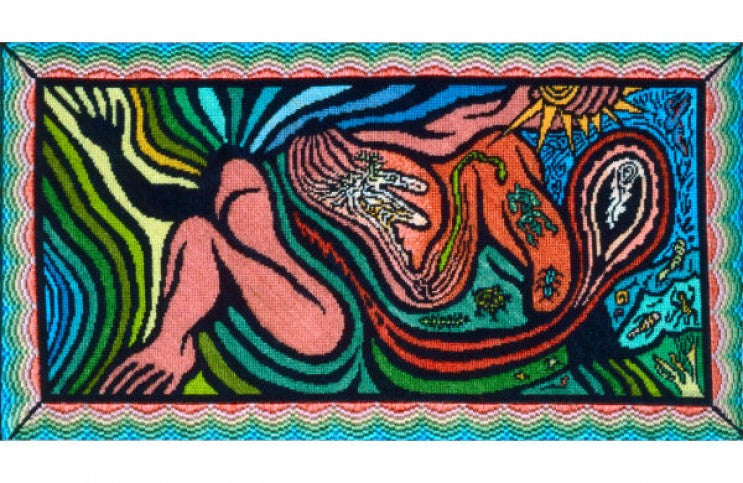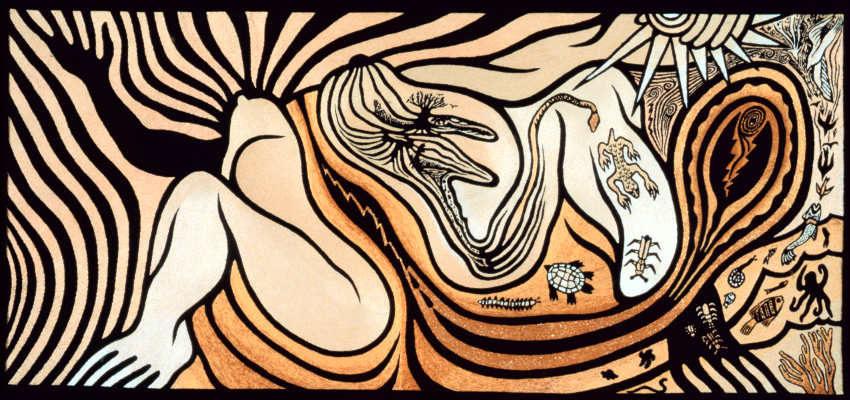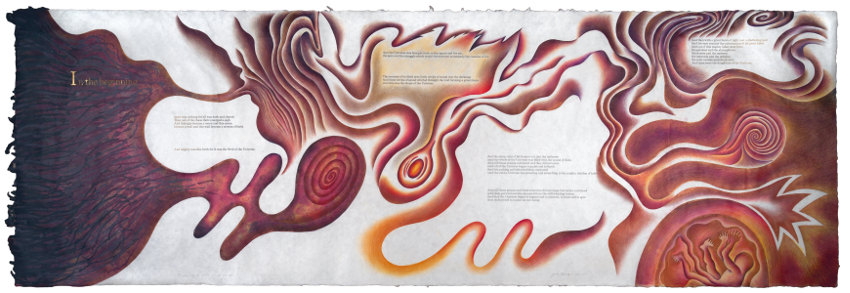
Motherhood, Maternity, Femaleness, Gender - Judy Chicago’s Birth Project
Between the years 1980 and 1985, Judy Chicago enlisted more than 150 needleworkers to collaborate with her on the creation of dozens of large-scale tapestries that formed the basis for a monumental exhibition called Birth Project. As Chicago describes it, the exhibition was intended as a celebration of “the birth-giving capacity of women along with their creative spirit.” In addition to the tapestries, the exhibition included numerous symbolic paintings and drawings by Chicago exploring motherhood, femininity, and creation. Through the Flower, a Feminist art non-profit that Chicago founded in 1978, organized the Birth Project tour, which eventually visited more than 100 venues across the United States. At the end of the tour, Through the Flower donated the works to various institutions free of charge. Suffice to say, everything about this exhibition was revolutionary, from the fact that Chicago shared equal public credit for the work with each of the needleworkers who collaborated with her, to the fact that the works were donated rather than sold. But it was the content of the work that was most revolutionary. It not only celebrated femininity, but it also re-contextualized the creation of the universe as a fundamentally female event, reversing centuries of female diminishment at the hands of patriarchal Western creation narratives, and bringing attention to the plain fact that women obviously embody the most essential aspect of human existence: birth. And if, while reading this, you are getting the feeling that perhaps this is a message that might bear repeating today, you are not alone. Curator Viki D. Thompson Wylder thought the same thing. She has brought the exhibition back in modified form, as Judy Chicago’s Birth Project: Born Again. A “reassembling” of more than a dozen of the original works, this rare and special exhibition offers a chance to not only revisit a key moment in Feminist contemporary art, but also to examine what questions and lessons this vital work holds for us today.
In the Beginning
Among the central conceits of many religious creation myths is that the creator of the universe A) is a sentient being, and B) has a gender. More often than not, that gender is perceived as male. And it is not just the creator that is frequently thought to have a gender, but many of the individual creations as well. In the year 1224, the Italian Catholic friar Francis of Assisi coined the phrase “Sister Moon” in a religious poem he wrote called Canticle of the Sun. That poem also assigns genders to a whole slew of other things, including Brother Sun, Brother Wind, Sister Water, Brother Fire, and Mother Earth. Most revealing, however, about the attitudes of the Catholic church is the final gender assignment Assisi makes in the third-to-last stanza of the poem, which reads: “Sister Bodily Death, from whom no living man can escape.” In his defense, being a friar, Assisi might have been a bit hazy on the subjects of female biology and human reproduction. But calling death a woman is just plain oxymoronic. If anything, women are the fountain of life.

Judy Chicago, Creation of the World E 3/9, 1984. Silkscreen and embroidery over drawing on fabric, 23¼ x 40½ inches. Embroidery by Merrily Rush Whitaker, Loan courtesy of Albuquerque Museum; Gift of "Through The Flower"
This fundamental misunderstanding is at the core of what Judy Chicago was trying to clear up with Birth Project. Most poignantly she addressed it in a series titled “Creation of the World.” In one work from this series, petit point needlework is used to portray a glorified image of all of the animals and natural elements of Earth springing forth from an ecstatic female body. In another, the same image is rendered on fabric with silkscreen and embroidery. A work titled “Creation of the World Scroll” (1981-82), which Chicago created using a mixture of Prismacolor pencils and lithography, attacks the gender myth of creation head on, as a cacophony of swirling, biomorphic energy waves co-mingle with embryonic and symbolic fecund forms. Written in four stanzas across the length of the scroll is a mythic poem penned by Chicago describing the creation of the universe and all matter in it. The poem describes the beginning as nothingness, from which comes a moan, which becomes a scream: a scream of birth—the birth of the universe. The “culmination of its great labor” is the planets, the stars, and all other matter. These things, Chicago writes, are “the daughters of the Universe.”

Judy Chicago, The Crowning Q5, 1982. Reverse appliqué and quilting over drawing on batik fabric, 56½ x 89 inches. Reverse appliqué and quilting by Jacquelyn (Moore) Alexander, Collection of the Florida State University Museum of Fine Arts
Teach Your Children Well
In conjunction with Judy Chicago’s Birth Project: Born Again, the Pasadena Museum of California Art has also organized a few side projects, a choice which adds a fascinating layer of depth to the overall concept of the show. One side project, called Birth Stories, lets visitors hear and read collected stories from contemporary Californians describing their own experiences with birth, as mothers, partners, and facilitators. What better way to add a concrete and personal element to the multi-layered abstract aspects that lurk in the works on view? Equally impactful are the other side projects that are meant specifically for children, such as the kids book area and the in-gallery educational space for children.

Judy Chicago, Creation of the World – Scroll, 1981-82. Lithography, gold leaf, and prismacolor, 38 1/4 x 100 1/2 inches. Courtesy of the Artist and Jessica Silverman Gallery
I find these aspects of the curation integral, because despite the magnitude and importance of the original Birth Project, a generation has passed with only slightly perceptible changes in the culture. I was a teenager when the exhibition first toured the United States. I remember hearing the name Judy Chicago from the adults around me, but only in conjunction with the opinion that her images were profane. I regret that no one took the time back then to help me understand that these images are in fact sacred. I am hopeful that this much-needed re-assembly of Birth project might also tour, not just the US but the world, along with its educational elements for kids. It would be wonderful to see a world thirty years from now in which the essential creative spirit of femininity is taken for granted. Until then, Judy Chicago’s Birth Project: Born Again is on view at the Pasadena Museum of California Art through 7 October 2018.
Featured image: Judy Chicago, Creation of the World PP2, 1984. Petit point over drawing on silk mesh, 10¾ x 15 inches. Petit Point by Jean Berens, Courtesy of the Artist, Through the Flower, and Salon 94, New York
By Phillip Barcio






